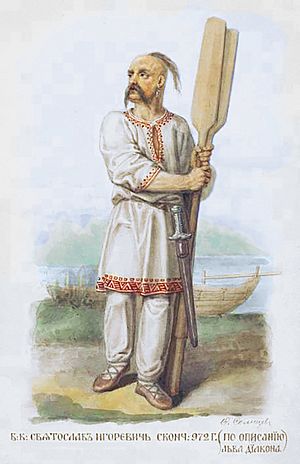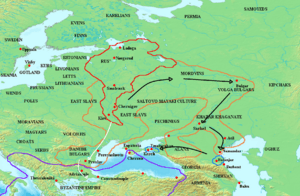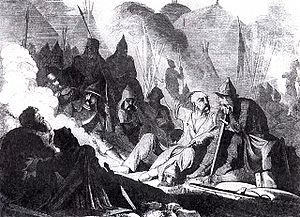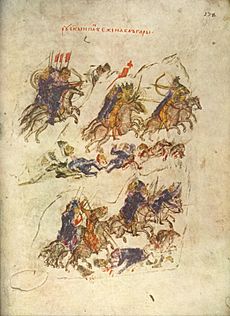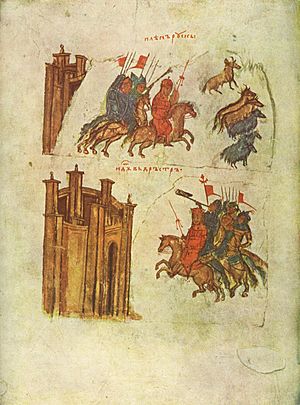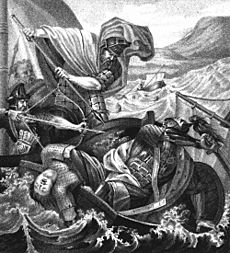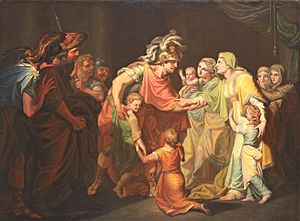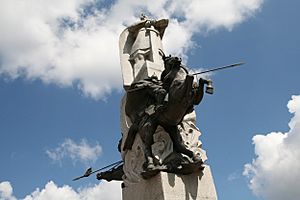Sviatoslav I of Kiev facts for kids
Quick facts for kids Sviatoslav the Brave |
|||||
|---|---|---|---|---|---|
| Grand Prince of Kiev | |||||
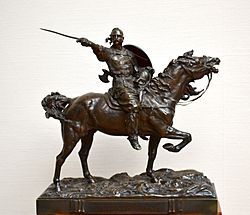
Sviatoslav I by Eugene Lanceray (1886)
|
|||||
| Reign | 945–972 | ||||
| Coronation | 964 | ||||
| Predecessor | Igor | ||||
| Successor | Yaropolk I | ||||
| Born | 942? AD Kiev |
||||
| Died | 26 March 972 AD [aged ~30] The island of Khortytsa Dnieper |
||||
| Wives |
|
||||
| Issue | With unknown woman: Yaropolk I Oleg With Malusha: Vladimir the Great |
||||
|
|||||
| Dynasty | Rurik Dynasty | ||||
| Father | Igor | ||||
| Mother | Saint Olga (regent 945-964) | ||||
Sviatoslav I Igorevich (born around 942, died March 26, 972) was a powerful Grand Prince of Kiev. He was known for his many military campaigns that led to the fall of two major states in Eastern Europe: Khazaria and the First Bulgarian Empire. He also conquered many East Slavic tribes, defeated the Alans, and attacked the Volga Bulgars. Sometimes, he teamed up with the Pechenegs and Magyars.
During his ten years as ruler, the Kievan Rus' expanded quickly into the Volga River valley, the Pontic steppe, and the Balkans. By the end of his life, Sviatoslav had created the largest state in Europe. In 969, he even moved his capital from Kiev (in modern-day Ukraine) to Pereyaslavets (now Nufăru, Romania) on the Danube River. Unlike his mother, who became a Christian, Sviatoslav remained a pagan his whole life. Because he died suddenly in an ambush, his many conquests were not fully organized into a lasting empire. Also, he didn't set up a clear plan for who would rule next, which led to a conflict among his three sons, and two of them were killed.
Contents
Sviatoslav's Early Life and Personality
Almost nothing is known about Sviatoslav's childhood. He spent his early years in Novgorod. His father, Igor, was killed by the Drevlians around 945. After this, his mother, Olga, ruled as a regent in Kiev until Sviatoslav was old enough to rule (around 963).
Sviatoslav was taught by a Varangian named Asmud. This tradition of having Varangian tutors for princes continued for a long time. Sviatoslav didn't seem to enjoy managing the state. He spent his life with his druzhina (a group of loyal warriors) constantly fighting against neighboring states.
According to old records, Sviatoslav traveled light on his expeditions. He didn't use wagons or cooking pots. He didn't even boil meat. Instead, he would cut small pieces of horse meat, game, or beef and roast them over coals to eat. He also didn't use a tent. He would just spread a horse-blanket on the ground and use his saddle as a pillow. All his warriors did the same.
A writer named Leo the Deacon described Sviatoslav very clearly. Leo saw Sviatoslav meet with Emperor John I Tzimiskes. Leo said Sviatoslav had bright eyes and was of average height but very strong. He had a bald head, a thin beard, a bushy mustache, and a sidelock (a long lock of hair) as a sign of his royal status. He liked to wear white clothes, which were much cleaner than his men's clothes. He wore a single large gold earring with a carbuncle (a type of gem) and two pearls.
Sviatoslav's Beliefs
Sviatoslav's mother, Olga, became a Christian in 957. She converted to Eastern Orthodox Christianity at the court of the Byzantine Emperor Constantine VII. However, Sviatoslav remained a pagan throughout his life.
In a treaty from 971 between Sviatoslav and the Byzantine emperor John I Tzimiskes, the Rus' warriors swore by the pagan gods Perun and Veles. According to the Primary Chronicle, Sviatoslav believed that if he became a Christian, his warriors would lose respect for him and make fun of him. The loyalty of his warriors was extremely important for him to conquer and control his large state.
Sviatoslav's Family
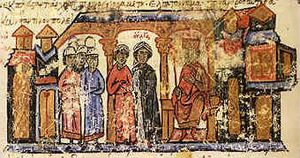
Not much is known about Sviatoslav's family life. He had several children, but the records don't clearly state who their mothers were. He had two sons, Yaropolk and Oleg, by his wives. He also had a son named Vladimir with a woman named Malusha. Vladimir later turned away from his father's pagan beliefs and led the conversion of Rus' to Christianity.
Sviatoslav's Eastern Campaigns
Soon after becoming ruler, Sviatoslav began military campaigns to expand Rus' control. He wanted to take over the Volga valley and the Pontic steppe region. His biggest success was conquering Khazaria, which had been one of the most powerful states in Eastern Europe for centuries.
Historians believe the Rus' wanted to remove the Khazars' control over the Volga trade route. The Khazars collected taxes on goods transported along this important river. The Byzantine Empire might have also encouraged the Rus' to fight the Khazars.
Sviatoslav started by gathering East Slavic tribes who were under Khazar rule to join his side. Tribes like the Vyatichs who refused were attacked and forced to pay tribute to the Kievan Rus' instead of the Khazars. A legend says Sviatoslav sent a message to the Vyatich rulers with just one phrase: "I want to come at you!" This phrase is still used today to mean a clear declaration of one's intentions.
Sviatoslav traveled along the Oka and Volga rivers and attacked Volga Bulgaria. He used Oghuz and Pecheneg warriors to help him. These mercenaries likely helped him fight against the strong cavalry of the Khazars and Bulgars.
Around 965, Sviatoslav destroyed the Khazar city of Sarkel. He might have also attacked the Khazar city of Kerch in Crimea. At Sarkel, he built a Rus' settlement called Belaya Vyezha, which means "the white tower" or "the white fortress." He then destroyed the Khazar capital of Atil. A visitor to Atil wrote after Sviatoslav's campaign: "The Rus' attacked, and no grape or raisin remained, not a leaf on a branch."
Even though Sviatoslav attacked many Khazar cities, he didn't permanently occupy the Khazar lands north of the Caucasus Mountains. On his way back to Kiev, Sviatoslav attacked the Ossetians and forced them to obey him. The destruction of the Khazar Empire allowed Kievan Rus' to control the important north-south trade routes across the steppe and the Black Sea. These routes had been a major source of wealth for the Khazars. Sviatoslav's campaigns also led to more Slavic people settling in the region, changing the population and culture there.
Sviatoslav's Campaigns in the Balkans
The destruction of Khazaria happened while the Rus' and the Byzantine Empire were allies. They had formed a close military relationship after Igor's Byzantine campaign in 944. For example, a Rus' group joined the Byzantine Emperor Nikephoros II in his successful naval trip to Crete.
In 967 or 968, Emperor Nikephoros sent his agent, Kalokyros, to Sviatoslav. Kalokyros's job was to convince Sviatoslav to help the Byzantines fight against Bulgaria. Sviatoslav was paid 15,000 pounds of gold and set sail with an army of 60,000 men, including thousands of Pecheneg warriors.
Sviatoslav defeated the Bulgarian ruler Boris II and took control of all of northern Bulgaria. Meanwhile, the Byzantines paid the Pechenegs to attack Kiev, where Sviatoslav's mother Olga and his son Vladimir were staying. The Pecheneg siege was lifted, and after they retreated, Olga sent a letter to Sviatoslav, telling him off. He quickly returned and defeated the Pechenegs, who continued to threaten Kiev.
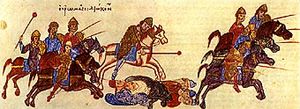
Sviatoslav refused to give his Balkan conquests to the Byzantines, which caused a disagreement between them. Despite his advisors and his mother being upset, Sviatoslav decided to move his capital to Pereyaslavets at the mouth of the Danube River. He believed this location had great potential as a trading center. In the Primary Chronicle from 969, Sviatoslav explained that "all the riches flow" to Pereyaslavets: "gold, silks, wine, and various fruits from Greece, silver and horses from Hungary and Bohemia, and from Rus' furs, wax, honey, and slaves."
In the summer of 969, Sviatoslav left Rus' again. He divided his lands into three parts, with each part ruled by one of his sons. Leading an army that included Pecheneg and Magyar troops, he invaded Bulgaria again. He attacked Thrace, captured the city of Philippopolis, and killed its people. Nikephoros responded by strengthening Constantinople's defenses and forming new groups of armored cavalry. While preparing, Nikephoros was overthrown and killed by John Tzimiskes, who became the new Byzantine emperor.
John Tzimiskes first tried to convince Sviatoslav to leave Bulgaria, but he failed. Sviatoslav challenged Byzantine power, crossed the Danube, and attacked Adrianople in the summer of 970. This caused panic in Constantinople. Later that year, the Byzantines launched a counterattack. John Tzimiskes sent his commander, Bardas Skleros, who defeated the combined forces of Rus', Pechenegs, Magyars, and Bulgarians in the Battle of Arcadiopolis. Meanwhile, John, after stopping a revolt, came to the Balkans with a large army. He presented himself as the liberator of Bulgaria from Sviatoslav. He went through difficult mountain passes and soon captured Marcianopolis, where the Rus' were holding several Bulgarian princes hostage.
Sviatoslav retreated to Dorostolon, which the Byzantine armies besieged for sixty-five days. Trapped and surrounded, Sviatoslav made a deal with John. He agreed to leave the Balkans, give up his claims to southern Crimea, and return west of the Dnieper River. In return, the Byzantine emperor gave the Rus' food and safe passage home. Sviatoslav and his men sailed to Berezan Island at the mouth of the Dnieper, where they camped for the winter. Several months later, their camp suffered from a severe famine. The Kievan chronicler reported that even a horse's head could not be bought for less than half a grivna. While Sviatoslav's campaign didn't bring lasting gains for the Rus', it weakened Bulgaria, making it vulnerable to attacks later on.
Sviatoslav's Death
The Byzantine emperor feared that the peace with Sviatoslav would not last. So, he encouraged the Pecheneg khan Kurya to kill Sviatoslav before he reached Kiev. This was part of a Byzantine strategy to cause conflict between the Rus' and the Pechenegs.
According to the Slavic chronicle, Sveneld tried to warn Sviatoslav to avoid the Dnieper rapids. However, the prince ignored his advice. He was ambushed and killed by the Pechenegs when he tried to cross the rapids near Khortitsa in early 972. The Primary Chronicle says that the Pecheneg khan made Sviatoslav's skull into a chalice.
After Sviatoslav's death, tensions grew among his sons. A war broke out between his sons, Oleg and Yaropolk, in 976. Oleg was killed in this conflict. In 977, Vladimir fled Novgorod to avoid Oleg's fate. He went to Scandinavia, where he gathered an army of Varangians and returned in 980. Yaropolk was killed, and Vladimir became the sole ruler of Kievan Rus'.
Sviatoslav in Art and Literature
Sviatoslav has long been seen as a hero by people in Belarus, Russia, and Ukraine because of his great military successes. His story became popular among Russian artists and poets during the Russo-Turkish War (1768–1774). This war had similarities to Sviatoslav's push towards Constantinople. Russia's expansion south and the plans of Catherine II in the Balkans seemed to be supported by Sviatoslav's campaigns centuries earlier.
One work from that time was Yakov Knyazhnin's play Olga (1772). The Russian playwright made Sviatoslav the main character, even though his active role in events after Igor's death doesn't quite match historical timelines. Ivan Akimov's painting Sviatoslav's Return from the Danube to Kiev (1773) shows the conflict between military honor and family ties.
Interest in Sviatoslav grew in the 19th century. Klavdiy Lebedev painted a famous scene of Sviatoslav meeting Emperor John Tzimiskes. Eugene Lanceray created an equestrian statue of Sviatoslav in the early 20th century. Sviatoslav also appears in Velimir Khlebnikov's 1913 poem Written before the war, where he represents a strong Slavic warrior.
In 2011, a Ukrainian fisherman found a one-meter-long sword in the Dnieper River near Khortytsia. This is where Sviatoslav is believed to have been killed in 972. The sword's handle is made of four different metals, including gold and silver. It is possible that this sword belonged to Sviatoslav himself.
Images for kids
See also
 In Spanish: Sviatoslav I de Kiev para niños
In Spanish: Sviatoslav I de Kiev para niños


